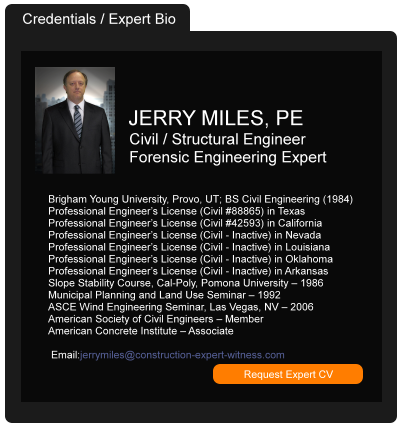Discussion of the Discovery Rule and Tolling Statute of Limitations
February 26, 2015 —
Beverley BevenFlorez-CDJ STAFFAttorney Clay Olson analyzed a recent South Carolina appeals case that “discussed the threshold for ‘notice’ as it pertains to statute(s) of limitations in construction defect cases. At the root of this action was a 2003 forensic report obtained by the HOA which was not acted upon until 2009.”
Olson presented the background of the case as well as the case progression. Olson concluded, “It is well settled that an expert’s findings, when presented to a claimant, trigger the statute of limitations as to the specific defective conditions and locale where defects are present. This case is interesting in its treatment of the initial report as a trigger of all defects in not only the main building which was subject of the 2003 report, but additional structures.”
Read the court decisionRead the full story...Reprinted courtesy of
Do Construction Contracts and Fraud Mix After All?
October 27, 2016 —
Christopher G. Hill – Construction Law MusingsOn several occasions here at Construction Law Musings, I’ve discussed the fact that, with a few exceptions, fraud claims and written construction contract based claims do not mix. One of the exceptions to the so called “economic loss rule” that would seem to preclude both fraud and contract claims in the same lawsuit is where fraud is used to induce the contract in the first place. This exception would only apply where an independent duty, wholly outside of the duties created by the contract, is properly plead and proven to the court. For the same reason, namely a separate duty outside of the contract, the Virginia Consumer Protection Act (“VCPA”) may allow for an exception that would allow a cause of action under this statute.
Up until recently, the courts of Virginia have used these exceptions sparingly. However, the recent Loudoun County, VA Circuit Court opinion in Interbuild, Inc. v. Sayers (opinion also found at Virginia Lawyers Weekly) may signal a broadening of these exceptions. In the Interbuild case, the Court considered a claim for fraud in the inducement and breach of the VCPA. The basic facts plead by the plaintiffs were that Interbuild induced them into the contract through statements that it had been an established business since 1981, the project did not require a building permit, it had obtained all necessary subcontractor prices and would provide full-time project supervision, the project would be completed within 16 weeks, 4000 PSI concrete would be used for the project and that the project would be located in the agreed-upon area depicted and that they reasonably relied on these representations in deciding to enter into the contract to build their recreational facility.
Read the court decisionRead the full story...Reprinted courtesy of
Christopher G. Hill, The Law Office of Christopher G. Hill, PCMr. Hill may be contacted at
chrisghill@constructionlawva.com
Equipment Costs? It’s a Steal!
July 08, 2011 —
CDJ STAFFKCBD reports on the problems of a Lubbock, Texas contractor. It’s hard to do the job when your tools keep getting stolen. Corey Meadows, owner of Top Cut Interiors, told KCBD that he had chained an air compressor to a table saw. Since the thieves couldn’t cut the chain, they cut the table saw “and just took the air compressor and the chain.” Meadows estimates the thieves cost him $2,000 in damaged or stolen equipment and time lost.
Read the full story…
Read the court decisionRead the full story...Reprinted courtesy of
Granting Stay, Federal Court Reviews Construction Defect Coverage in Hawaii
January 06, 2012 —
Tred R. Eyerly - Insurance Law HawaiiThe federal district court ultimately stayed a construction defect case, but offered comments on the current status of coverage disputes for such defects in Hawaii. See National Union Fire Ins. Co. of Pittsburgh, Pa. v. Simpson Mfg. Co., 2011 U.S. Dist. LEXIS 128481(D. Haw. Nov. 7, 2011).
National Union filed a complaint for declaratory relief to establish it had no duty to defend or to indemnify Simpson Manufacturing Company in four actions pending in the Hawaii state courts. The state court actions concerned allegedly defective hurricane strap tie hold downs that were manufactured and sold by Simpson. The hurricane ties allegedly began to prematurely corrode and rust, causing cracking, spalling and other damage to homes.
National Union contended the underlying allegations did not constitute "property damage" caused by an "occurrence," as defined in the policies.
Read the full story…
Reprinted courtesy of Tred R. Eyerly, Insurance Law Hawaii. Mr. Eyerly can be contacted at te@hawaiilawyer.com
Read the court decisionRead the full story...Reprinted courtesy of
Builders Beware: Smart Homes Under Attack by “Hide ‘N Seek” Botnet
October 30, 2018 —
Scott L. Satkin & Amtoj S. Randhawa - Newmeyer & Dillion LLPGerman manufacturer eQ-3 has found itself under siege by a botnet known as "Hide 'N Seek." This pernicious malware has infected tens of thousands of eQ-3's smart home devices by compromising the device's central control unit. Once a device has been infected, the malware spreads to other Internet of Things ("IoT") devices connected to the same wireless network. IoT devices have become the prime target for botnet attacks. As opposed to computers, laptops, or other larger computing devices, the smaller storage capacity and lower processing power of IoT devices limit the amount and complexity of the security measures that can be installed—making them an easier target for botnets.
What is a Botnet?
For those unfamiliar with the term, a botnet is a network of devices infected with a malware program allowing the infector to control and/or exploit the devices. Once a suitable number of devices are infected, the person or group controlling the botnet can harness the computing power of each infected device to perform activities which were previously constrained by a single device's capabilities (i.e. DDoS attacks, spamming, cryptocurrency mining, etc.).
Hide 'N Seek – History and Capabilities
The Hide 'N Seek botnet first appeared in January 2018 and has since spread rapidly. Its sophisticated design and capabilities have captivated the attention of many security watchdogs and researchers. While many botnets are designed to be "quick and dirty" (i.e. infect a few devices, eke out a little profit, and inevitably be cleared out or rendered ineffective by security updates and fixes), Hide 'N Seek was designed to maintain itself in the host's system indefinitely. When it was first released, Hide 'N Seek primarily targeted certain routers and internet-enabled security cameras; however, it has now began targeting digital video recorders, database servers, and most recently, smart home hubs.
Hide 'N Seek's communication capabilities are also more advanced than previous botnets. Previous botnets relied on existing communications protocols to communicate with other another, but Hide 'N Seek uses a custom-built peer-to-peer system to communicate. This advancement allows Hide 'N Seek to spread more rapidly than previous botnets.
Hide 'N Seek is also capable of extracting a device owner's personal information (i.e. name, address, e-mail, telephone numbers, etc.) whereas previous botnets were not. Most importantly, Hide 'N Seek is consistently updated to increase its infection rate, decrease its detection probability, and bypass any security measures designed to detect and remove it from the system. This modularity has proved to be Hide 'N Seek's greatest strength.
Protecting Against Hide 'N Seek and Other Botnets
While many of the precautions will undoubtedly come from the device manufactures vis-à-vis software programming and updates, homebuilders can still take some precautions to protect their customers.
- When selecting a smart home system to incorporate into a home's construction, be sure to evaluate its security features including, but not limited to its: wireless connectivity, password/passphrase requirements, interconnectedness with other IoT devices, etc. Third-party reviews from tech-oriented outlets will likely have useful information on a device's security measures, vulnerabilities, and any recent security compromises.
- Be vigilant in installing any eQ-3 smart home systems. The extent of the damage caused by Hide 'N Seek botnet remains unknown, as does damage from other potentially-infected technology. Thus, it may be prudent to avoid installing any eQ-3 device until it becomes evident that the threat has been neutralized and all security vulnerabilities have been remedied.
- If a builder uses technology other than eQ-3, precautions must be taken. Ensure that technology providers are thoroughly researched. It is also recommended to include strong contractual indemnity provisions, and require vendors to carry cyber-specific insurance policies.
- Homebuilders should consider purchasing their own stand alone cyber liability policies as a safety net, should potential exposure arise.
Scott Satkin and Amtoj Randhawa are associates in the Cybersecurity group of Newmeyer & Dillion. Focused on helping clients navigate the legal dispute implications of cybersecurity, they advise businesses on implementing and adopting proactive measures to prevent and neutralize cybersecurity threats. For questions on how they can help, contact Scott at scott.satkin@ndlf.com and Amtoj at amtoj.randhawa@ndlf.com.
Read the court decisionRead the full story...Reprinted courtesy of
When it Comes to COVID Emergency Regulations, Have a Plan
December 07, 2020 —
Christopher G. Hill - Construction Law MusingsAs I hope readers of this construction corner of the “blogosphere” know, Virginia adopted emergency COVID workplace regulations effective July 27, 2020, and with enforcement beginning at the end of September. Among the various items found in these regulations are general requirements for all employers, including among others, the requirement to self determine the employer’s risk level and disinfecting requirements. The regulations also have some requirements that seem specially directed toward construction industry employers. These include among them engineering controls and various requirements relating to communications with subcontractors. For a good overview of these requirements, see this great post at the Virginia Bar Association’s construction law blog.
One item that is not included in the emergency regulations is a statement that following the regulations immunizes an employer from COVID infection-related lawsuits. For this reason, among others, all construction (and other industry) employers should have a COVID plan that meets the requirements of these regulations at whatever “hazard level” that employer meets. These plans should be written and distributed to all employees and include protocols for workplace/job site screening and what to do if there is a need for contact tracing. I also highly recommend that any plan be created with the help of a good Virginia workplace safety consultant well versed in the COVID regulations.
Read the court decisionRead the full story...Reprinted courtesy of
The Law Office of Christopher G. HillMr. Hill may be contacted at
chrisghill@constructionlawva.com
Los Angeles Construction Sites May Be on Fault Lines
December 30, 2013 —
CDJ STAFFCalifornia law prohibits building near or on top of earthquake fault lines, but Los Angeles County building officials may have used outdated information that misreported the location of certain faults. The Los Angeles Times reports that after their earlier articles on fault lines, the officials have started using newer maps.
According to the older maps, an apartment building under construction on Brockton Avenue in Los Angeles is 1.9 miles away from the Santa Monica fault. But a more recent map, created by the state in 2010, shows that the fault line could potentially be right under the building site.
The builders of another apartment building potentially located on the Santa Monica fault said that the city did not ask for a fault investigation. The Los Angeles Department of Building and Safety said that there was no official zone designation for the Santa Monica fault, and so did not require seismic studies.
Read the court decisionRead the full story...Reprinted courtesy of
When Coronavirus Cases Spike at Construction Jobsites
July 27, 2020 —
Richard Korman, Scott Judy & Jeff Rubenstone - Engineering News-RecordWhen Covid-19 took hold in several US states in early spring, Choate Construction responded, as many contractors did, by quickly adopting federal workplace safety guidelines for disinfecting surfaces and maintaining social distancing. Enhanced by various state lockdown measures for businesses and the general public, the new safety system seemed to work with only a handful of workers on Choate’s projects testing positive.
Reprinted courtesy of Engineering News-Record reporters
Richard Korman,
Scott Judy and
Jeff Rubenstone
Mr. Korman may be contacted at kormanr@enr.com
Mr. Judy may be contacted at judys@enr.com
Mr. Rubenstone may be contacted at rubenstonej@enr.com
Read the full story... Read the court decisionRead the full story...Reprinted courtesy of


































































